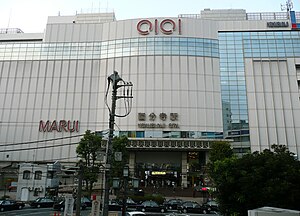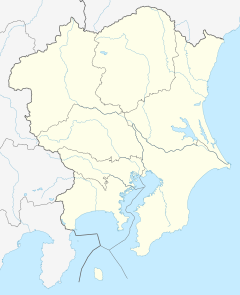Kokubunji Station (国分寺駅, Kokubunji-eki) is an interchange railway station located in the city of Kokubunji, Tokyo, Japan, operated by East Japan Railway Company (JR East) and private railway operator Seibu Railway.[1]
Kokubunji Station 国分寺駅 | |
|---|---|
 Kokubunji Station station building, October 2011 | |
| Japanese name | |
| Shinjitai | 国分寺駅 |
| Kyūjitai | 國分寺驛 |
| Hiragana | こくぶんじえき |
| General information | |
| Location | 2-chome Honmachi, Kokubunji City, Tokyo Japan |
| Coordinates | 35°42′01″N 139°28′49″E / 35.70028°N 139.48028°E |
| Operated by | |
| Line(s) | |
| Connections | |
| Construction | |
| Structure type | At grade |
| Other information | |
| Station code |
|
| History | |
| Opened | 11 April 1889 |
| Location | |
Lines edit
Kokubunji Station is served by the Chūō Line (Rapid) and is 31.4 kilometers from the terminus of the line at Tokyo. It also forms a terminus for both the Seibu Kokubunji and Seibu Tamako lines.
Station layout edit
The JR East side of the station consists of two island platforms serving four tracks. The station has a "Midori no Madoguchi" staffed ticket office.[1] The Seibu portion of the station has one side of a former island platform (Platform 5) parallel to and north of the JR platforms.[2] Platform 6 is now closed.[2] Platform 7 is further north again but is above and perpendicular to the other platforms.[2]
JR East edit
JC16 Kokubunji Station 国分寺駅 | ||||||||||||||||||||||||||||||
|---|---|---|---|---|---|---|---|---|---|---|---|---|---|---|---|---|---|---|---|---|---|---|---|---|---|---|---|---|---|---|
| JR East exit, July 2015 | ||||||||||||||||||||||||||||||
| General information | ||||||||||||||||||||||||||||||
| Location | 2-1-23 Honchō, Kokubunji-shi, Tokyo 185-0021 Japan | |||||||||||||||||||||||||||||
| Operated by | JR East | |||||||||||||||||||||||||||||
| Line(s) | ■ Chūō Line (Rapid) | |||||||||||||||||||||||||||||
| Distance | 21.1 km (13.1 mi) from Shinjuku | |||||||||||||||||||||||||||||
| Platforms | 2 island platforms | |||||||||||||||||||||||||||||
| Tracks | 4 | |||||||||||||||||||||||||||||
| Construction | ||||||||||||||||||||||||||||||
| Structure type | At grade | |||||||||||||||||||||||||||||
| Other information | ||||||||||||||||||||||||||||||
| Status | Staffed ( "Midori no Madoguchi" ) | |||||||||||||||||||||||||||||
| Station code | JC16 | |||||||||||||||||||||||||||||
| History | ||||||||||||||||||||||||||||||
| Opened | 11 April 1889 | |||||||||||||||||||||||||||||
| Passengers | ||||||||||||||||||||||||||||||
| FY2019 | 112,090 daily | |||||||||||||||||||||||||||||
| Services | ||||||||||||||||||||||||||||||
| ||||||||||||||||||||||||||||||
JR Platforms edit
| 1/2 | JC Chūō Line (Rapid) | for Tachikawa and Hachiōji |
| 3/4 | JC Chūō Line (Rapid) | for Nakano, Shinjuku, and Tokyo |
-
The passenger waiting room on platform 5, November 2013
Seibu Railway edit
SK01 ST01 Kokubunji Station 国分寺駅 | |||||||||||||||
|---|---|---|---|---|---|---|---|---|---|---|---|---|---|---|---|
| Seibu station | |||||||||||||||
| Seibu Kokubunji Line train at platform 5, November 2013 | |||||||||||||||
| General information | |||||||||||||||
| Location | 2-1-23 Honchō, Kokubunji-shi, Tokyo 185-0021 Japan | ||||||||||||||
| Operated by | Seibu Railway | ||||||||||||||
| Line(s) | |||||||||||||||
| Platforms | 2 side platforms | ||||||||||||||
| Other information | |||||||||||||||
| Station code | SK01, ST01 | ||||||||||||||
| History | |||||||||||||||
| Opened | 21 December 1894 | ||||||||||||||
| Passengers | |||||||||||||||
| FY2019 | 117,796 daily | ||||||||||||||
| Services | |||||||||||||||
| |||||||||||||||
Seibu Platforms edit
| 5 | Seibu Kokubunji Line | for Ogawa and Higashi-Murayama |
| 7 | Seibu Tamako Line | for Hagiyama and Tamako |
-
The east end of platform 5 viewed from the JR East platforms, November 2013
-
Seibu Kokubunji Station Platform 7, April 2021
History edit
What is now the JR East station opened on 11 April 1889.[3] The Seibu Kokubunji Line platforms opened on 21 December 1894, and the Tamako Railway (present-day Seibu Tamako Line) platforms opened on 6 April 1928.[2]
Station numbering was introduced on all Seibu Railway lines during fiscal 2012, with Kokubunji Station becoming "SK01" on the Seibu Kokubunji Line and "ST01" on the Seibu Tamako Line.[4]
Passenger statistics edit
In fiscal 2019, the station was used by an average of 112,090 passengers daily (boarding passengers only), making it the 31st busiest in the JR East network.[5] The Seibu station was used by an average of 117,796 passengers daily making it the sixth busiest station served by Seibu.[6] The passenger figures for previous years are as shown below. Note that JR East figures consider only boarding passengers whereas Seibu figures consider both entering and exiting passengers.
| Fiscal year | JR East | Seibu |
|---|---|---|
| 2000 | 100,815[7] | |
| 2005 | 103,862[8] | 116,629[9] |
| 2010 | 105,883[10] | 114,779[11] |
| 2015 | 111,325[12] | 118,392[13] |
Surrounding area edit
North side edit
South side edit
- Tonogayato Garden
- Hotel Mets Kokubunji
- Tokyo Keizai University
- Tokyo University of Agriculture and Technology
See also edit
References edit
- ^ a b 各駅情報(国分寺駅) [Station Information (Kokubunji Station)] (in Japanese). Japan: East Japan Railway Company. Retrieved 26 November 2012.
- ^ a b c d Kawashima, Ryozo (February 2011). 日本の鉄道 中部ライン 全線・全駅・全配線 第11巻 埼玉南部・東京多摩北部 [Railways of Japan - Chubu Line - Lines/Stations/Track plans - Vol 11 Southern Saitama and Northern Tama Tokyo]. Japan: Kodansha. pp. 10–88. ISBN 978-4-06-270071-9.
- ^ Kawashima, Ryozo (May 2010). 日本の鉄道 中部ライン 全線・全駅・全配線 第2巻 三鷹駅―八王子エリア [Railways of Japan - Chubu Line - Lines/Stations/Track plans - Vol 2 Mitaka Station - Hachioji Area]. Japan: Kodansha. p. 43. ISBN 978-4-06-270062-7.
- ^ 西武線全駅で駅ナンバリングを導入します [Station numbering to be introduced at all Seibu stations] (PDF). News Release (in Japanese). Japan: Seibu Railway. 23 February 2012. Archived from the original (PDF) on 24 September 2015. Retrieved 17 November 2013.
- ^ 各駅の乗車人員 (2020年度) [Station passenger figures (Fiscal 2020)] (in Japanese). Japan: East Japan Railway Company. Retrieved 29 January 2021.
- ^ 各駅の乗車人員 (2020年度) [Station passenger figures (Fiscal 2020)] (in Japanese). Japan: Seibu Railway. Retrieved 29 January 2021.
- ^ 各駅の乗車人員 (2000年度) [Station passenger figures (Fiscal 2000)] (in Japanese). Japan: East Japan Railway Company. Archived from the original on 9 October 2014. Retrieved 17 November 2013.
- ^ 各駅の乗車人員 (2005年度) [Station passenger figures (Fiscal 2005)] (in Japanese). Japan: East Japan Railway Company. Archived from the original on 9 October 2014. Retrieved 17 November 2013.
- ^ 駅別乗降人員 2005(平成17)年度 1日平均 [Average daily station usage figures (fiscal 2005)] (PDF) (in Japanese). Japan: Seibu Railway. Archived from the original (PDF) on 5 March 2016. Retrieved 18 August 2014.
- ^ 各駅の乗車人員 (2010年度) [Station passenger figures (Fiscal 2010)] (in Japanese). Japan: East Japan Railway Company. Archived from the original on 6 October 2014. Retrieved 17 November 2013.
- ^ 駅別乗降人員 2010(平成22)年度 1日平均 [Average daily station usage figures (fiscal 2010)] (PDF) (in Japanese). Japan: Seibu Railway. Archived from the original (PDF) on 26 June 2011. Retrieved 17 November 2013.
- ^ 各駅の乗車人員 (2015年度) [Station passenger figures (Fiscal 2015)] (in Japanese). Japan: East Japan Railway Company. Retrieved 2 September 2020.
- ^ 駅別乗降人員 2015(平成27)年度 1日平均 [Average daily station usage figures (fiscal 2015)] (PDF) (in Japanese). Japan: Seibu Railway.
External links edit
Media related to Kokubunji Station at Wikimedia Commons
- Kokubunji Station information (JR East) (in Japanese)
- Station information (Seibu) (in Japanese)


